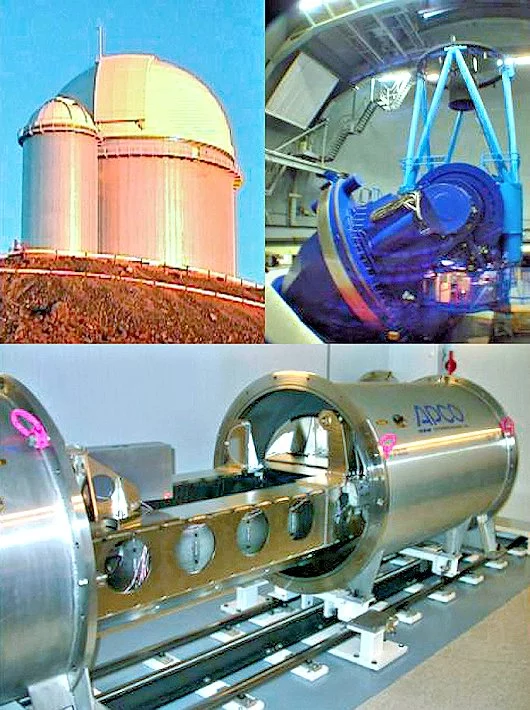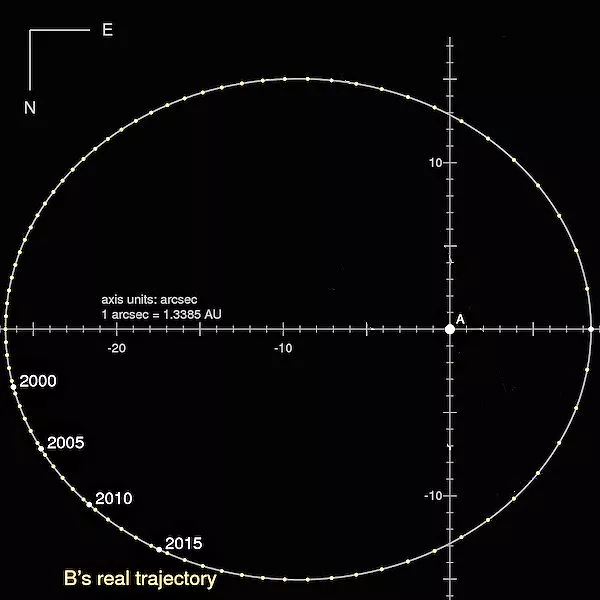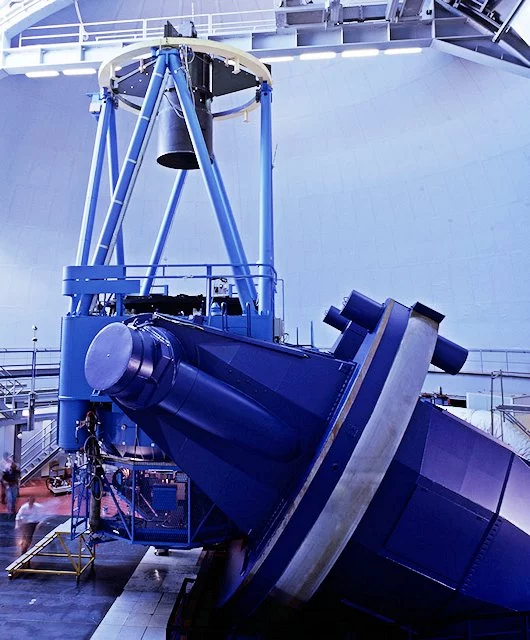European astronomers working from the European Southern Observatory (ESO) in Chile have discovered a planet slightly more massive than Earth, orbiting a star in the Alpha Centauri triple star system – the nearest stellar system to our planet. Alpha Centauri Bb (as the new exoplanet is called, the star being Alpha Centauri B) is the first Earth-sized body found orbiting a Sun-like star and was discovered by measuring the tiny wobbles of Alpha Centauri B as it moves in response to the gravitational pull of the orbiting planet. It is orbiting Alpha Centauri B every three days and six hours at an orbital radius of six million kilometers (3.7 million miles). The proximity to the star leads to a surface temperature of some 1,500º K (2,250º F/1,232º C) – hot enough to melt granite.
The Alpha Centauri system is one of the brightest stars in our night sky, exceeded in brightness only by Sirius and Canopus. At a distance of 1.34 parsecs (4.37 light years) it is the nearest stellar system to our Solar System. It is actually a triple star – a system consisting of two stars similar to the Sun orbiting close to each other, designated Alpha Centauri A and B, and a more distant and faint red dwarf known as Proxima Centauri or Alpha Centauri C (C is called Proxima at times because it is the closest of the three stars in the Alpha Centauri system, at 1.29 parsecs (4.24 light years) distance).
Alpha Centauri A is the largest of the trio, having the same spectral classification as the Sun, a mass of 1.1 solar masses, and a luminosity about 1.5 times that of the Sun. Alpha Centauri B is the star around which the new planet has been found orbiting. It is an orange dwarf with a mass of 0.9 solar masses. The orange color is the result of being about 900º K cooler than A, and this also results in B having a luminosity 0.5 times that of the Sun.
Alpha Centauri C (Proxima Centauri) is a dim red dwarf with a mass of 0.123 solar masses and a luminosity less than 0.2 percent that of the Sun. It is located about a quarter of a light year from the A-B pair, which orbit each other with a period of 80 years at an average distance of 23 astronomical units (AU – the distance between Earth and the Sun) – a bit more than the distance between the Sun and Uranus. It is not entirely clear that C is gravitationally bound to A and B, that is, if C actually orbits the A-B pair, or if it is in a hyperbolic path around them and will escape their grip in the next few million years. The escape velocity at Proxima's distance from A and B is about 0.5 km/second (0.3 miles/second), which is smaller than the present uncertainty in Proxima's speed relative to A and B. The general consensus at this time is that Proxima is probably the third member of the triple star system Alpha Centauri.
Orange dwarf stars have many features that make them excellent candidates for hosting life-bearing planets. They evolve slowly as hydrogen burning stars along the main sequence for 15 to 30 billion years compared to the Sun's 10 billion years, giving more time for life to appear and evolve. They support a habitable zone from roughly 0.5 to one AU orbital radius from the star, which is enough distance that a planet in that zone will not be tidally locked to the star. Orange dwarfs have low stellar flare activity and emit small quantities of ionizing radiation, as well as exhibiting generally more placid stellar dynamics (e.g., pulsations, chromospheric activity, sunspots (starspots?), etc.) than either hotter or cooler stars. The result is that orange dwarfs are often considered "Goldilocks stars" – prime candidates for the formation and steady evolution of life.

Alpha Centauri Bb was detected using the High Accuracy Radial velocity Planet Searcher (HARPS) instrument on the 3.6-meter (11.8-foot) telescope at ESO’s La Silla Observatory in Chile. HARPS measures the radial velocities of stars with the highest accuracy available. To achieve very high long term radial velocity accuracy, HARPS is designed as an echelle spectrograph optimized for mechanical stability. It is optically fed by a pair of fibers from the Cassegrain focus of the 3.6 m (11.8 ft) telescope, one fiber picking up the light of the star being measured, and the other being fed a reference spectrum. HARPS is mounted in a vacuum chamber to avoid spectral drift due to temperature and air pressure variations.
HARPS detects exoplanets using a method known as the Doppler wobble. As a planet orbits a star, in reality each of them orbits their mutual center of mass. The center of mass for a pair of bodies is the point on a massless connecting rod where a teeter-totter would be evenly balanced. For example, Jupiter has about 0.001 of the mass of the Sun, and orbits at a distance of about 740 million kilometers (460 million miles). The center of mass is a point 0.001 x 740 million kilometers = 740,000 kilometers from the center of the Sun. This is a point just above the surface of the Sun.
This seems a lot of movement, but it takes place over Jupiter's 12-year orbital period. Once you work out the geometry, the maximum speed of the radial wobble is about 12 m/s. This produces a small Doppler effect whereby the spectrum of the Sun will show a periodic redshift with a magnitude or 12 m/s / 300,000,000 m/s, or 40 parts in a billion. To measure such tiny velocities through their redshifts requires not only the highest resolution spectrographs, but also state-of-the-art data collection and analysis techniques. In discovering Alpha Centauri Bb, HARPS detected radial velocity changes of 0.5 m/s – a very slow walk and the very limit of this technique with present technology. In this case, the center of mass lies only 22 kilometers (13.7 miles) from the center of Alpha Centauri B.
To detect an Earth-mass planet orbiting in the habitable zone of Alpha Centauri B would require detecting radial velocity changes of about 0.1 m/s – a sensitivity within reach of near-future instruments. Such an instrument is the Echelle SPectrograph for Rocky Exoplanet and Stable Spectroscopic Observations (ESPRESSO), which will offer a tenfold improvement in the detection threshold for Doppler wobble, thereby making possible the discovery of Earth-size planets in the habitable zone of Sun-sized stars.
ESPRESSO is to be installed in 2016 at the ESO's Very Large Telescope (VLT), also located in Chile. The VLT includes four 8.2-meter (26.9-foot) individual telescopes, which can be used individually or coupled together to attain the equivalent resolution of a 130-meter (424-foot) telescope – about 0.001 arc second. The VLT in its combined mode would allow two people standing at arms length on the surface of the Moon to be seen as separate objects.
As Earth-sized planets in Alpha Centauri B's habitable zone have not yet been discovered or ruled out, it is worth revisiting an old controversy that is still not resolved. Namely, can planets form in a binary or multiple star system at all? Well, we know they can – Alpha Centauri certainly has a planet, as do 15 other binary or multiple stars as of this writing. In fact, the binary systems NN Serpentis and HW Virginis each have two confirmed exoplanets.

However, the basic issues of planetary orbital stability and the planet formation dynamics in the ever-changing gravitational fields of a binary system are still not well understood. It is like cuckoo clocks on a wall – eventually even a small interaction will cause the clocks to tick in unison. A planet is too small to do anything but what the nearby stars allow. As a result, either the planet will follow an orbit that is consistent with the variable gravitational forces which act on it, or it will be thrown off into a very different orbit – possibly even escaping the system.
Let's illustrate this situation by looking at a hypothetical Earth-sized planet Hypo orbiting Alpha Centauri B at a radius of 0.7 astronomical units – within the habitable zone. Alpha Centauri A orbits every 80 years at distances between 11.2 and 35.6 AU. The gravitational pull of B on Hypo is about 0.01 m/s2. The gravitational pull of A on Hypo varies between 0.0002 and 0.00002 m/s2 – it is between two and 0.2 percent of B's pull on Hypo, and changes direction and size in a (relatively) fixed pattern with a period of 80 years.
When external influences on a planet's orbit are slow and small, the angular momentum of the planet is approximately conserved. This is not to say that the orbit will not be affected – you can imagine that Hypo's orbit will have a "tidal bulge" of various sizes that points toward A – but the orbit will not change dramatically. Given what we know about tides, it seems reasonable that Hypo may be able to remain in its orbit.
What about Hypo's brother, Hype? Hype orbits B at a distance of 5 AU. The gravitational pull of A on Hype varies from 7.5 to 325 percent of the pull of B on Hype. In this case, it is clear that Hype will not be able to maintain a well-behaved orbit around B. It is pulled more strongly toward A than toward B for a significant part of the 80 year orbit of A and B.
Somewhere between 5 AU and 0.7 AU will be an orbital distance after which a planet's orbit will be unstable in the long run. Similar problems will appear as the early planetesimals coalesce into clouds and then into planets – strong and variable gravitational fields will disperse the material. It is a difficult problem to determine what is the maximum "safe" orbital distance. However, what has been observed is that low-mass planets tend to be found in multiple-planet systems, so we may yet find a friendly neighbor in the Alpha Centauri system.
The video below shows an artist's conception of what a person on a trip through the Alpha Centauri system, including passes by the new exoplanet, might experience.
Source: ESO







